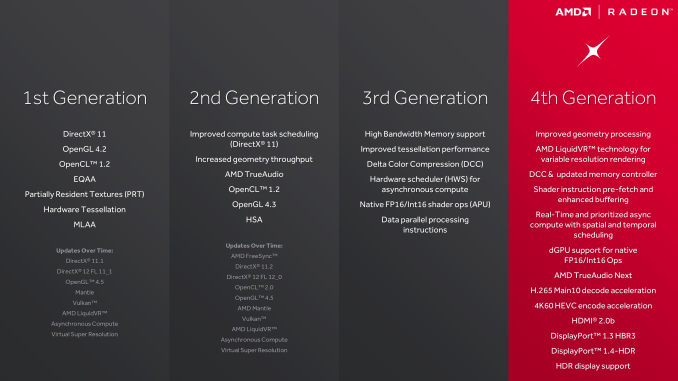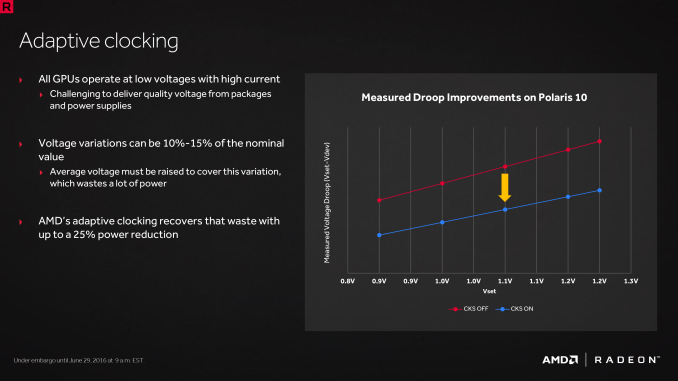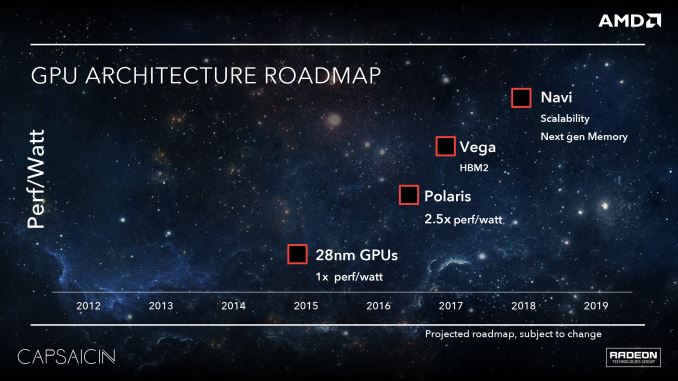The AMD Radeon RX 480 Preview: Polaris Makes Its Mainstream Mark
by Ryan Smith on June 29, 2016 9:00 AM ESTAMD's Path to Polaris
With the benefit of hindsight, I think in reflection that the 28nm generation started out better for AMD than it ended. The first Graphics Core Next card, Radeon HD 7970, had the advantage of launching more than a quarter before NVIDIA’s competing Kepler cards. And while AMD trailed in power efficiency from the start, at least for a time there they could compete for the top spot in the market with products such as the Radeon HD 7970 GHz Edition, before NVIDIA rolled out their largest Kepler GPUs.
However I think where things really went off of the rails for AMD was mid-cycle, in 2014, when NVIDIA unveiled the Maxwell architecture. Kepler was good, but Maxwell was great; NVIDIA further improved their architectural and energy efficiency (at times immensely so), and this put AMD on the back foot for the rest of the generation. AMD had performant parts from the bottom R7 360 right up to the top Fury X, but they were never in a position to catch Maxwell’s efficiency, a quality that proved to resonate with both reviewers and gamers.
The lessons of the 28nm generation were not lost on AMD. Graphics Core Next was a solid architecture and opened the door to AMD in a number of ways, but the Radeon brand does not exist in a vacuum, and it needs to compete with the more successful NVIDIA. At the same time AMD is nothing if not scrappy, and they can surprise us when we least expect it. But sometimes the only way to learn is the hard way, and for AMD I think the latter half of the 28nm generation was for the Radeon Technologies Group learning the hard way.
So what lessons did AMD learn for Polaris? First and foremost, power efficiency matters. It matters quite a lot in fact. Every vendor – be it AMD, Intel, or NVIDIA – will play up their strongest attributes. But power efficiency caught on with consumers, more so than any other “feature” in the 28nm generation. Though its importance in the desktop market is forum argument fodder to this day, power efficiency and overall performance are two sides of the same coin. There are practical limits for how much power can be dissipated in different card form factors, so the greater the efficiency, the greater the performance at a specific form factor. This aspect is even more important in the notebook space, where GPUs are at the mercy of limited cooling and there is a hard ceiling on heat dissipation.
As a result a significant amount of the work that has gone into Polaris has been into improving power efficiency. To be blunt, AMD has to be able to better compete with NVIDIA here, but AMD’s position is more nuanced than simply beating NVIDIA. AMD largely missed the boat on notebooks in the last generation, and they don’t want to repeat their mistakes. At the same time, starting now with an energy efficient architecture means that when they scale up and scale out with bigger and faster chips, they have a solid base to work from, and ultimately, more chances to achieve better performance.
The other lesson AMD learned for Polaris is that market share matters. This is not an end-user problem – AMD’s market share doesn’t change the performance or value of their cards – but we can’t talk about what led to Polaris without addressing it. AMD’s share of the consumer GPU market is about as low as it ever has been; this translates not only into weaker sales, but it undermines AMD’s position as a whole. Consumers are more likely to buy what’s safe, and OEMs aren’t much different, never mind the psychological aspects of the bandwagon effect.
Consequently, with Polaris AMD made the decision to start with the mainstream market and then work up from there, a significant departure from the traditional top-down GPU rollouts. This means developing chips like Polaris 10 and 11 first, targeting mainstream desktops and laptops, and letting the larger enthusiast class GPUs follow. The potential payoff for AMD here is that this is the opposite of what NVIDIA has done, and that means AMD gets to go after the high volume mainstream market first while NVIDIA builds down. Should everything go according to plan, then this gives AMD the opportunity to grow out their market share, and ultimately shore up their business.
As we dive into Polaris, its abilities, and its performance, it’s these two lessons we’ll see crop up time and time again, as these were some of the guiding lessons in Polaris’s design. AMD has taken the lessons of the 28nm generation to heart and have crafted a plan to move forward with the FinFET generation, charting a different, and hopefully more successful path.
Though with this talk of energy efficiency and mainstream GPUs, let’s be clear here: this isn’t AMD’s small die strategy reborn. AMD has already announced their Vega architecture, which will follow up on the work done by Polaris. Though not explicitly stated by AMD, it has been strongly hinted at that these are the higher performance chips that in past generations we’d see AMD launch with first, offering performance features such as HBM2. AMD will have to live with the fact that for the near future they have no shot at the performance crown – and the halo effect that comes with it – but with any luck, it will put AMD in a better position to strike at the high-end market once Vega’s time does come.













449 Comments
View All Comments
D. Lister - Thursday, June 30, 2016 - link
@fanofanandWhat he is saying is, that the total power draw of the 2x 1080 from the motherboard is less than 75W, because they take most of the power from the 8-pin connectors, which is true. The same statement is also true for the Radeon 290X, a GPU well-known for massive power use. But even 2x 290/290Xs don't draw so much from the board.
Please refrain from abusive language and think before you post, because it only puts you, your argument and your brand of choice, in a negative light.
fanofanand - Friday, July 1, 2016 - link
You are choosing to scold me for calling him out on his word choices that portray an inaccurate statement? Of all the people on here and all the things they say? Mr. Lister, kindly F off.D. Lister - Saturday, July 2, 2016 - link
:) well, no one who has ever scolded me, used the word "please". Anyhow, you misunderstood the guy, didn't conduct any research in the matter, and instead of replying with an opposing argument/reference you asked for his post to be deleted and then called him an idiot. Acting like that only serves to push you in a weaker position, and drags AT down to the level of places like wccftech. Anyway, I will now kindly F off.Murloc - Tuesday, July 5, 2016 - link
lol what he says puts "his brand of choice" in negative light'guys please get a grip
D. Lister - Tuesday, July 5, 2016 - link
Yeah, complicated, but you'll figure it out once you're done laughing out loud. :)Mode+ - Thursday, June 30, 2016 - link
Standard 12V 6 pin connector is rated up to 192W without the HCS terminals. The specification is for 150W. It's a guideline, not a rule.TheinsanegamerN - Thursday, June 30, 2016 - link
And my car is rated to go up to 120MPH. Doesnt mean that it will work well for long at that speed.Rumpeltroll80 - Monday, July 4, 2016 - link
That is why many are releasing the RX 480 with a 8 pin instead of 6 pin. 150 Watt on a 8 pin, only 75 watt on a 6 pin.So problem seems to be solved then right? Here is one card with the change
http://www.tweaktown.com/news/52878/sapphires-upco...
komplik - Thursday, June 30, 2016 - link
Really? https://www.techpowerup.com/reviews/AMD/RX_480_Cro...In average... slower than single 1070
erple2 - Friday, July 1, 2016 - link
I didn't see that from the charts - I saw it to be faster. Personally, I ignored resolutions below 1440p, as buying 2 of these for those resolutions seems pointless.In the aggregate including games where there was no crossfire scaling, the 1070 was competitive, and slightly faster.